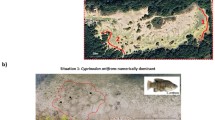Summary
Territorial fidelity and competition between males was studied in a population of individually marked willow warblers (Phylloscopus trochilus). After spending the winter in Africa males arrive in the study area in late April or the beginning of May. They can be separated into two categories, old colour-banded males that return for a new breeding attempt, and birds that are new to the study area. These new birds could either be birds that had bred the previous year returning to a different site, or more likely 1-year-old birds returning for their first breeding attempt. Old males show high site fidelity and are successful in retaining their territories from the preceding year. The few old males that switched territories between years seemed to do so in response to reduced breeding success in the preceding year. However, in 13 out of 14 cases when a new resident was already established on the previous resident's territory, the old male was successful in evicting the new resident. In a removal experiment both old and new birds were removed from their territories and then released when a replacement male had been established. All old males successfully managed to reclaim their original territories after escalated contests. None of the new males were successful and no fights were observed.
Similar content being viewed by others
References
Alcock J (1975) Territorial behaviour by males of Philanthus multimaculatus (Hymenoptera: Sphecidae) with a review of territoriality in male Sphecids. Anim Behav 23:889–895
Arcese P, Smith JNM (1985) Phenotypic correlates and ecological consequences of dominance in song sparrows. J Anim Ecol 54:817–830
Barnard CJ, Brown CAJ (1982) The effects of prior residence, competitive ability and food availability on the outcome of interactions between shrews (Sorex araneus L.). Behav Ecol Sociobiol 10:307–312
Davies NB (1978) Territorial defence in the speckled wood butterfly (Pararge aegeria): The residents always win. Anim Behav 26:136–147
Davies NB, Halliday TR (1978) Deep croaks and fighting assessment in toads Bufo bufo. Nature 274:683–685
Davies NB, Lundberg A (1984) Food distribution and variable mating system in the dunnock, Prunella modularis. J Anim Ecol 53:895–912
Enquist M, Jakobsson S (1986) Decision making and assessment in the fighting behaviour of Nannacara anomala (Cichlidae, Pisces). Ethology 72:143–153
Enquist M, Leimar O (1987) Evolution of fighting behaviour: the effect of variation in resource value. J theor Biol 127:187–205
Enquist M, Plane E, Röed J (1985) Aggressive communication in fulmars (Fulmarus glacialis) competing for food. Anim Behav 33:1007–1020
Hinde RA (1956) The biological significance of the territories of birds. Anim Behav 98:340–369
Hyatt GW, Salmon M (1978) Combat in fiddler crabs Uca pugilator: a quantitative analysis. Behaviour 65:182–211
Kikkawa J (1980) Winter survival in relation to dominance classes among silvereyes Zosterops lateralis chlorocephala of Heron Island, Great Barrier Reef. Behaviour 122:437–446
Krebs JR (1982) Territorial defence in the Great Tit (Parus major): Do residents always win? Behav Ecol Sociobiol 11:185–194
Lanyon SM, Thompson CF (1986) Site fidelity and habitat quality as determinants of the settlement pattern in male painted buntings. Condor 88:206–210
Leimar O, Enquist M (1984) Effects of asymmetries in owner-intruder conflicts. J theor Biol 111:475–491
Maynard Smith J (1974) The theory of games and the evolution of animal conflicts. J theor Biol 47:209–222
Maynard Smith J (1976) Evolution and the theory of games. Am Sci 64:41–45
Maynard Smith J, Parker GA (1976) The logic of asymmetric contests. Anim Behav 24:159–175
Metzgar LA (1975) An experimental comparison of screech owl predation on resident and transient white-footed mice. J Mammal 48:387–390
Nolan V (1978) The ecology and behavior of the prairie warbler Dendroica discolor. Ornithol Monogr 26:1–595
Oring LW, Lank DB (1982) Sexual selection, arrival times, philopatry and site fidelity in the polyandrous spotted sandpiper. Behav Ecol Sociobiol 10:185–191
Otronen M (1984) Male contests for territories and females in the fly Dryomyza anilis. Anim Behav 32:891–898
Parker GA (1974) Assessment strategy and the evolution of fighting behaviour. J theor Biol 47:223–243
Radesäter T, Jakobsson S, Andbjer N, Bylin A, Nyström K (1987) Song rate and pair formation in the willow warbler (Phylloscopus trochilus). Anim Behav (in press)
Rand WM, Rand AS (1976) Agonistic behavior in nesting iguanas: A stochastic analysis of dispute settlement dominated by the minimization of energy cost. Z Tierpsychol 40:279–299
Riechert SE (1978) Games spiders play: behavioral variability in territorial disputes. Behav Ecol Sociobiol 3:135–162
Robinson SK (1985) Fighting and assessment in the yellow-rumped cacique (Cacicus cela). Behav Ecol Sociobiol 18:39–44
Robinson SK (1986) Benifits, costs, and determinants of dominance in a polygynous oriole. Anim Behav 34:241–255
Searcy WA (1979) Male characteristics and pairing success in red-winged blackbirds. Auk 96:353–363
Tiainen J (1983) Dynamics of a local population of the willow warbler Phylloscopus trochilus in southern Finland. Ornis Scand 14:1–15
Trail PW (1985) Territoriality and dominance in the lekbreeding Guianan cock-of-the-rock. Nat Geograph Res 1:112–123
Walton R, Nolan V (1986) Imperfect information and the persistence of pretenders: male prairie warblers contesting for territory. Am Nat 128:427–432
Yasukawa K (1981) Male quality and female choice of mate in the red-winged blackbird (Agelaius phoeniceus). Ecology 62:922–929
Yasukawa K, Bick EI (1983) Dominance hierarchies in darkeyed juncos (Junco hyemalis): a test of a game-theory model. Anim Behav 31:439–448
Author information
Authors and Affiliations
Rights and permissions
About this article
Cite this article
Jakobsson, S. Territorial fidelity of willow warbler (Phylloscopus trochilus) males and success in competition over territories. Behav Ecol Sociobiol 22, 79–84 (1988). https://doi.org/10.1007/BF00303541
Received:
Accepted:
Issue Date:
DOI: https://doi.org/10.1007/BF00303541




